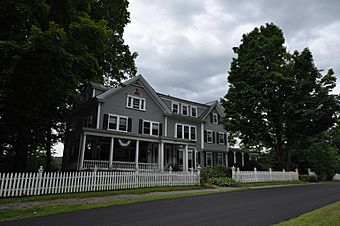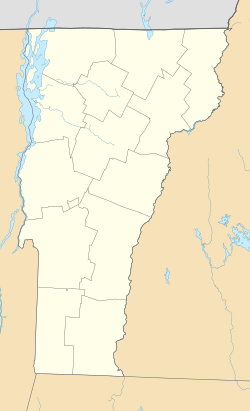Dewey House (Hartford, Vermont) facts for kids
Quick facts for kids |
|
|
Dewey House
|
|
 |
|
| Location | 173 Deweys Mills Rd., Hartford, Vermont |
|---|---|
| Area | less than one acre |
| Built | 1903 |
| Architectural style | Colonial Revival |
| NRHP reference No. | 99001051 |
| Added to NRHP | August 27, 1999 |
The Dewey House is a special old house located at 173 Deweys Mills Road in Hartford, Vermont. It was built a long time ago, in 1876, by a local mill owner. Later, in 1903, it was updated. This house is a great example of a building style called Colonial Revival architecture. Because it's so important historically and architecturally, it was added to the National Register of Historic Places in 1999.
What Makes the Dewey House Special?
The Dewey House stands on the northwest side of Deweys Mills Road. This road used to be a main path between the Deweys Mills village and a train station.
A Look at the House's Design
The house is a two-and-a-half-story building made of wood. It has a unique roof shape and its outside walls are covered with clapboards, which are long, thin pieces of wood. The bottom part of the house is made of brick and fieldstone.
The roof has two pointed sections, called gables, facing the front. These gables are connected by a smaller, sloped roof section. On the left side of the house, there's a porch that goes across the front and wraps around the side. This porch is held up by round columns. There's also another porch on the right side of the house.
One cool feature on the left gable is a special window called a Palladian window. It has a large arched window in the middle with two smaller, rectangular windows on each side. Inside the house, you can see how it was updated in the early 1900s.
Who Lived in the Dewey House?
The oldest part of the house, the section on the left, was built around 1876. It started as a smaller, one-and-a-half-story house in the Cape style. It was built by A.G. Dewey, who owned the local mills called Dewey's Mills.
From the house, you can see the nearby Ottauquechee River and the pond that was once used by Dewey's mills. The mills themselves are no longer there; they were taken down in the 20th century as part of a dam project.
Over the years, the Dewey family added more parts to the house, making it the size and shape it is today. When the house was added to the National Register in 1999, it was still owned by the descendants of the original Dewey family.



